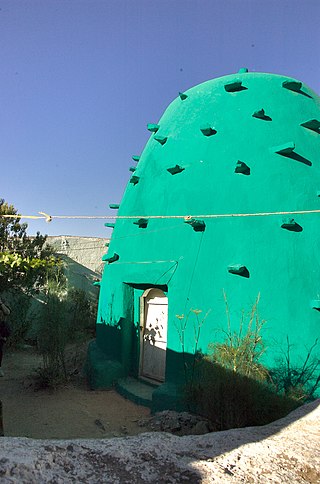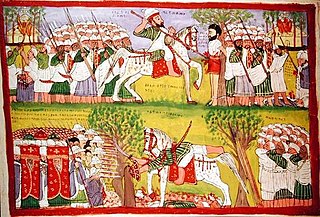
The Adal Sultanate, also known as the Adal Empire or Bar Saʿad dīn, was a medieval Sunni Muslim Empire which was located in the Horn of Africa. It was founded by Sabr ad-Din III on the Harar plateau in Adal after the fall of the Sultanate of Ifat. The kingdom flourished c. 1415 to 1577. At its height, the polity under Sultan Badlay controlled the territory stretching from Cape Guardafui in Somalia to the port city of Suakin in Sudan. The Adal Empire maintained a robust commercial and political relationship with the Ottoman Empire. Sultanate of Adal was alternatively known as the federation of Zeila.

Ahmad ibn Ibrahim al-Ghazi was the Imam of the Adal Sultanate from 1527 to 1543. Commonly named Ahmed Gragn in Amharic and Gurey in Somali, both meaning the left-handed, he led the invasion and conquest of Abyssinia from the Sultanate of Adal during the Ethiopian-Adal War. He is often referred to as the "King of Zeila" in medieval texts.

Dawit II, also known by the macaronic name Wanag Segad, better known by his birth name Lebna Dengel, was Emperor of Ethiopia from 1508 to 1540, whose political center and palace was in Shewa.

Galawdewos, also known as Mar Gelawdewos, was Emperor of Ethiopia from 3 September 1540 until his death in 1559, and a member of the Solomonic dynasty. His throne name was Atsnaph Sagad I. A male line descendant of medieval Amhara kings, he was a younger son of Dawit II and Seble Wongel.
Mahfuz was a Garad, Emir of Harar and Governor of Zeila in the Adal Sultanate. Although he was originally only emir of a small region he would rise to become leader of Adal due to his popularity, wielding more power than the sultan of Adal. He is often known as the "Captain of Zeila" in medieval texts.
Hadiya also known as Adea or Hadia was a medieval Muslim state in the southern part of its realm located south of Shewa and west of Sharkha. The Hadiya Muslim state mainly composed of Cushitic Hadiyya proper, Halaba, Kebena people as well as Semitic Sil'te and other tongues related to Harari language. Hadiya was historically a vassal state of the Adal federation and then became an autonomous province of Abyssinia in the fourteenth century while still remaining a member of the Zeila union. In the 1600s Hadiya regained its independence and was led by a Garad. By 1850, Hadiya is placed north-west of lakes Zway and Langano but still between these areas.
The Battle of Shimbra Kure was fought on 9 March 1529 between the forces of Adal led by Imam Ahmad ibn Ibrahim al-Ghazi, and the Abyssinian army, under Dawit II. It was the first major battle of the Ethiopian–Adal War.
The Battle of Antukyah was fought in 1531 between Adal Sultanate forces under Imam Ahmad ibn Ibrahim al-Ghazi and the Abyssinian army under Eslamu. Huntingford has located Antukyah about 89 kilometres south of Lake Hayq, at the edge of the Ethiopian Highlands, in the modern district of Antsokiya and Gemza.

Nur al-Din or Nur ibn Mujahidibn ‘Ali ibn ‘Abdullah al Dhuhi Suha was an Emir of Harar who ruled over the Adal Sultanate. He was known for marrying his uncle's widow, Bati del Wambara, and also succeeding Imam Ahmad as the leader of the Muslim forces fighting Christian Ethiopia. He is often known as the "King of Adel" in medieval texts.

The Ethiopian–Adal War, also known as the Abyssinian–Adal War and in Arabic as Futūḥ Al-Ḥabaša, was a war fought between the Christian Ethiopian Empire and the Muslim Adal Sultanate from 1529 to 1543. The Christian Ethiopian troops consisted of the Amhara, Tigrayans, Tigrinya and Agaw people, and at the closing of the war, supported by the Portuguese Empire with no less than four hundred musketeers. The Adal forces were composed of Harla, Somali, Afar, as well as Arab and Turkish gunmen. Both sides would see the Maya mercenaries at times join their ranks.
Hintalo, also called Antalo, was Administrative Center of Enderta’s historical wereda of Gabat Melash, is a small town located in the Debub Misraqawi (Southeastern) Zone of the Tigray Region of Ethiopia. It lies on a plateau with an elevation variously reported as 2050 to 2102 meters above sea level. It lies some 20 miles south of Mekelle, the capital of Tigray. The urge to control this fortified mountainous place has provoked frequent engagements among various Tigrayan chiefs since the 17th century. Hintalo flourished as a town in the last quarter of the 18th and beginning of the 19th century.
Medri Bahri or Mereb Melash, also known as Ma'ikele Bahr or Bahr Melash was a semi-autonomous province of the Ethiopian Empire located north of the Mareb River, in the Eritrean highlands (Kebassa) and some surrounding areas. Mereb Melash corresponds to the administrative territory ruled by the Bahr Negus in medieval times. Mereb Melash comprised the historical provinces of Hamasien and Seraye.
The Jaarso, Giarso or Jarso is northern Somali clan, a sub-division of the Dir clan family They largely live in Ethiopia, in the Oromo Region and the Somali Region, especially in and around the ancient cities of Chinaksen, Harar and Jigjiga
Dawaro or Doaro was a Muslim principality which laid near Hadiya. The state was originally independent until becoming a vassal and later a province due its subjugation by Emperor Amda Seyon I in the early 14th century. The region was situated east of Hadiya and north of Bali which covered much of Ethiopia's Arsi Province. The capital of Dawaro was called Sabboch

The Geri Koombe is a sub-clan of Darod, a prominent Somali clan with the earliest records of Garadship. Gerikombe is one of the greatest tribes in Darod. Gerikombe kablalax darod ismacil jabarti. The Geri live in the Somali Region of Ethiopia between Tuli guled, Harar and Jigjiga, in Wardheer zone, in Bale, Bay, the Kismayo regions and in the Northern Frontier District of Kenya like Wajeer Garissa.

Matan ibn Uthman Bin Khalid (Somali: Mataan Ibnu Cismaan ibnu Khaalid, Arabic: متن بن عثمان بن خالد) born c. early 1490 – 28 October 1531, also known as Garad Matan, was a Somali military commander and Adalite general that served the Adal Sultanate. He led key and decisive battles, famously in charge of the Somali divisions. He was also the brother-in-law of Imam Ahmed and his right-hand man. Garad Matan played a very prominent role in the campaigns against the Abyssinians, killing the son of Lebna Dengel, Victor. Garad Matan hailed from the Geri Koombe clan and was also appointed the chieftain. He was regarded as one of the most courageous military generals in East Africa, well documented in the Futuh Al Habash.

The Habr Maqdi was a historical Somali confederation that composed of multiple clans such as the Bartire and Yabarre who are considered now a part of the Jidwaaq and come under the Absame Darod branch. The Habr Maqdi are well known for their conquests in Abyssinia as they had played a very prominent role in Ethiopian-Adal War. They are famous for bringing the largest army and were very loyal to Imam Ahmed. Richard Burton documented the Berteri branch of Habr Maqdi to have long been connected with the emirs of Harar. Both sub-clans of Habr Maqdi are mentioned explicitly in Futuh al-Habesh.
Eslamu Sagad was a general and nobleman in the Ethiopian Empire under Lebna Dengel who served as governor of Fatagar during the Ethiopian-Adal War.
Takla Iyasus was a general and nobleman in the Ethiopian Empire under Lebna Dengel who served as governor of Angot,Tigre, and the port of Dokono during the Ethiopian-Adal War.
The Battle of Bali was fought in 1532 between Adal Sultanate forces under Vizier Addoli and the Abyssinian army under Addalih, Governor of Bali.







